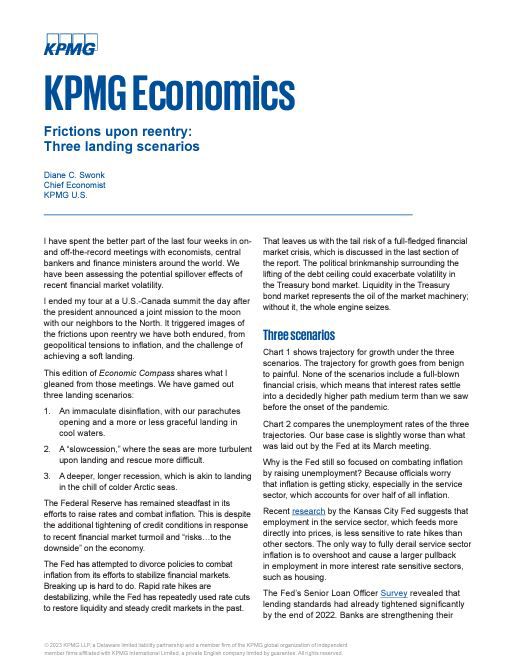I have spent the better part of the last four weeks in on and off-the-record meetings with economists, central bankers and finance ministers around the world. We have been assessing the potential spillover effects of recent financial market volatility.
I ended my tour at a U.S.-Canada summit the day after the president announced a joint mission to the moon with our neighbors to the North. It triggered images of the frictions upon reentry we have both endured, from geopolitical tensions to inflation, and the challenge of achieving a soft landing.
This edition of Economic Compass shares what I gleaned from those meetings. We have gamed out three landing scenarios:
- An immaculate disinflation, with our parachutes opening and a more or less graceful landing in cool waters.
- A “slowcession,” where the seas are more turbulent upon landing and rescue more difficult.
- A deeper, longer recession, which is akin to landing in the chill of colder Arctic seas.
The Federal Reserve has remained steadfast in its efforts to raise rates and combat inflation. This is despite the additional tightening of credit conditions in response to recent financial market turmoil and “risks…to the downside” on the economy.
The Fed has attempted to divorce policies to combat inflation from its efforts to stabilize financial markets. Breaking up is hard to do. Rapid rate hikes are destabilizing, while the Fed has repeatedly used rate cuts to restore liquidity and steady credit markets in the past.
That leaves us with the tail risk of a full-fledged financial market crisis, which is discussed in the last section of the report. The political brinkmanship surrounding the lifting of the debt ceiling could exacerbate volatility in the Treasury bond market. Liquidity in the Treasury bond market represents the oil of the market machinery; without it, the whole engine seizes.
For more information, download the full reports below.
The information contained herein is of a general nature and is not intended to address the circumstances of any particular individual or entity. Although we endeavor to provide accurate and timely information, there can be no guarantee that such information is accurate as of the date it is received or that it will continue to be accurate in the future. No one should act on such information without appropriate professional advice after a thorough examination of the particular situation.
READ MORE ARTICLES IN JP EXECUTIVE INSIGHT-ISSUE 2 2023
In this section, we provide a summary of brief updates from the previous quarter on legislative, judicial, and administrative developments in tax that may impact Japanese companies operating in the United States.


